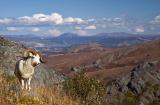Corridor Initiatives
Corridor Initiatives
Some corridors span thousands of miles, cross political borders, connect huge ecosystems filled with tens of thousands of species—and involve countless stakeholders from numerous walks of life. Conservation of such corridors requires extensive collaboration and the use of the best possible science. Notable examples of recent collaborative initiatives based on sound science include:
Southeastern Ecological Framework Project
The Southeastern Ecological Framework Project is a collaborative effort of the University of Florida and the US Environmental Protection Agency. This GIS-based analysis identified ecologically significant areas and their connectivity characteristics in the southeastern U.S. states of Florida, Kentucky, Tennessee, North Carolina, South Carolina, Georgia, Alabama, and Mississippi. Local, state, and federal decision-makers have used the subsequent project maps to inform conservation decisions across the region.
Freedom to Roam - Northern Great Plains
Freedom to Roam, an initiative of the World Wildlife Fund, is working to ensure that wildlife connectivity is a part of all land and wildlife management decisions in the Northern Great Plains of North America. The Northern Great Plains is the backyard for the iconic pronghorn antelope, 220 butterfly species, the American bison and golden eagles. In 2011, the region witnessed the longest documented land migration North America’s history. But the region is also undergoing extraordinary natural gas exploration, development and habitat shifts due to climate change. Without intact corridors, wildlife won’t be able to adapt to survive a rapidly changing landscape.
The Ecological Greenways Network
The Ecological Greenways Network is a statewide system of landscape hubs, linkages, and conservation corridors that was developed by the University of Florida using a GIS decision support model. Ecological Network connects and integrates existing conservation areas with unprotected areas of high ecological significance. These areas are prioritized based on factors such as the needs of wide-ranging species, importance for statewide connectedness and importance of riparian corridors.
Florida Trails Network
The Florida Trails Network supports the vision of the Office of Greenways and Trails to develop a statewide connected system of greenways and trails. Through this website, trail planners and users can view existing trails data and trails prioritization maps, submit GIS data for existing trails, give input on trail opportunities, and submit information for the Recreational Trails Program (RTP).
Priority Linkage Assessments
American Wildlands’ Priority Linkage Assessments identify over 100 wildlife linkages throughout western Montana based on ecological value, threat level, and conservation opportunity. Each linkage bridges the gap between larger core habitats and facilitates the movement of wildlife between them. These assessments are a first step toward addressing on-the-ground threats to habitat connectivity. American Wildlands actively shares this research with policy-makers and conservation partners for land-use and transportation-infrastructure planning.


